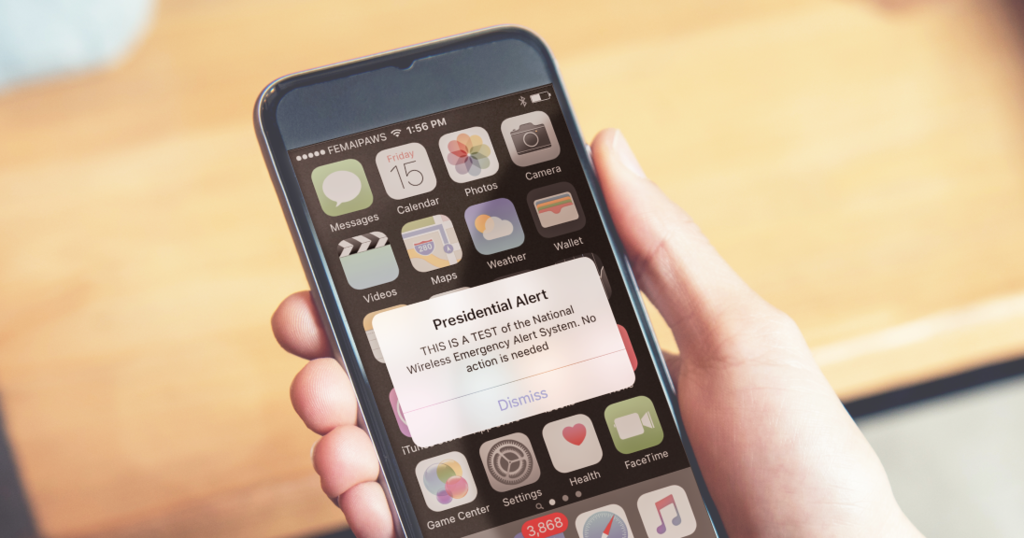FEMA, in coordination with the Federal Communications Commission (FCC), postponed the nationwide test of the Emergency Alert System (EAS) and Wireless Emergency Alerts (WEA) until October 3 due to ongoing response efforts to Hurricane Florence.
October 3 was the previously scheduled back-up date for the test, which was originally set up for this Thursday, September 20. A backup date is always planned in case of widespread severe weather or other significant events on the primary test date. FEMA and the nation’s emergency management community remain committed to the life-saving activities occurring through parts of North Carolina and South Carolina.
For further information on the test, go to https://www.fema.gov/emergency-alert-test.
The first Nationwide test of the Wireless Emergency Alert system (WEA) and the Emergency Alert System (EAS), both part of a system called the Integrated Public Alert and Warning System (IPAWS). This test is scheduled to take place on OCTOBER 3rd.
The WEA alerts are scheduled for 11:18 AM Pacific Time and the test message will be sent to all wireless providers that participate in IPAWS. These alerts will go to smart cellphone capable of receiving the alert, not all are, and on some cellphones this feature must first be turned on. Another variable – the cellphone must be within range of a capable celltower.
The EAS portion follows the WEA at 11:20 AM Pacific Time. This is the test message that goes to radio, TV, cable and direct satellite systems.
Some important facts:
The WEA system became operational April 2012.
This is the first Nationwide Test of these systems.
This is the first test of WEA in Oregon.
This is not part of Tillamook County or 911 Alert Notification Systems sent to specific cellphone numbers that are registered for the service. These alerts are sent to any and all capable cellphones within range of that celltower, it is not sent by standard text.
This is a FEMA test in coordination with the Federal Communication Commission. As such, the county does not control who does and who does not receive these alerts. If you want to stop getting these alerts, or you didn’t get the alert and wonder why, I suggest you get with your cellphone carrier to assist in making changes to your particular make and model cellphone.
Everyone needs to know that when the WEA test is activated, that no matter where you are, at work, at home, in the car, at school, in the doctor’s office, wherever, your phone, assuming it is capable, will activated to give you the test message.
Fact Sheet
A national test of the Emergency Alert System (EAS) and Wireless Emergency Alert (WEA) with radio, TV, cable stations and wireless carriers. IPAWS is a national system for local alerting that provides authenticated emergency alert and information messaging from emergency officials to the public through radio, TV, cell phones and Internet applications. This is the fourth EAS nationwide test since 2011 and the first national WEA test.
To be sure that in times of an emergency or disaster, public safety officials have methods and systems that will deliver urgent alerts and warnings to the public.
Periodic testing of public alert and warning systems is a way to assess the operational readiness of the infrastructure for distribution of a national message and determine whether technological improvements are needed.
The WEA system became operational in April 2012, and there has never been a nationwide WEA message sent. A nationwide WEA message would only be used in the most extreme emergency situation.
Nationwide – October 3rd:
•The WEA test commences at 11:18 AM Pacific Time (2:18 PM EDT); the EAS portion follows at 11:20 AM Pacific Time (2:20 PM EDT).
•The EAS test is expected to last approximately one minute and will verify the delivery and broadcast of a national test message and assess the operational readiness of the infrastructure for distribution of a national message and determine whether technological improvements are needed.
WHO: FEMA in coordination with the Federal Communications Commission (FCC).
The WEA test message will be sent to all wireless providers that currently participate in IPAWS. Cell towers will broadcast the WEA test for approximately 30 minutes. During this time, cell phones that are 1.) switched on, 2.) within range of an active cell tower, and 3.) whose wireless carrier participates in WEAs, should be capable of receiving the test message. Cell phones should receive the WEA message once.
The EAS test message will be made available and shared through radio, TV, cable, and direct broadcast satellite systems in all U.S. states and territories. Their participation in the test is mandatory per FCC rules. The WEA test message will be sent to all wireless providers that currently participate in IPAWS.


